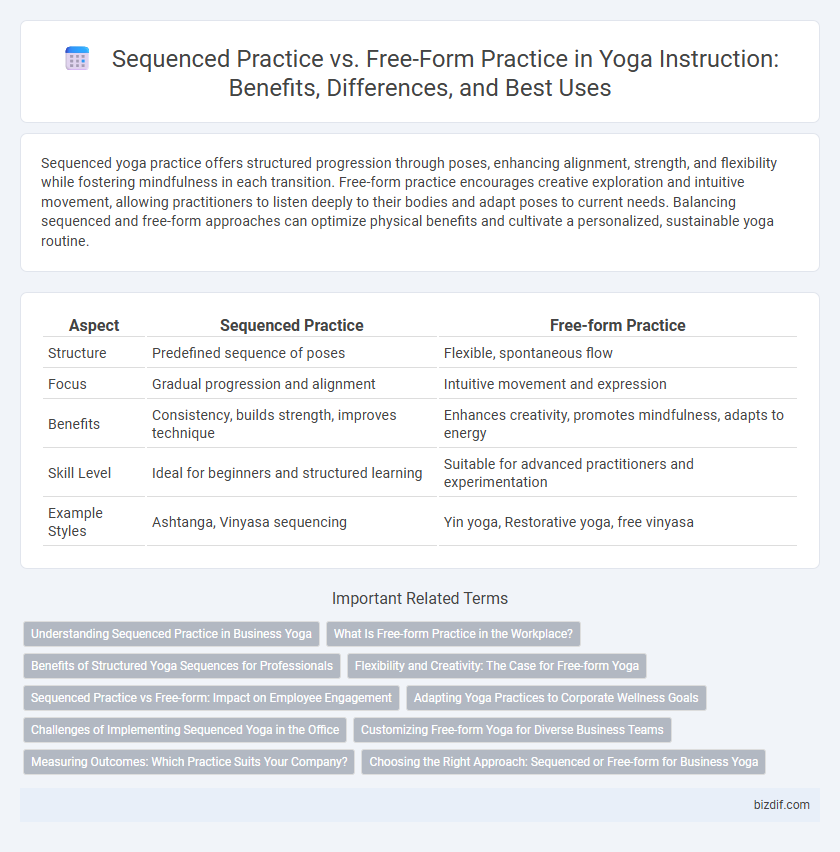Sequenced yoga practice offers structured progression through poses, enhancing alignment, strength, and flexibility while fostering mindfulness in each transition. Free-form practice encourages creative exploration and intuitive movement, allowing practitioners to listen deeply to their bodies and adapt poses to current needs. Balancing sequenced and free-form approaches can optimize physical benefits and cultivate a personalized, sustainable yoga routine.
Table of Comparison
| Aspect | Sequenced Practice | Free-form Practice |
|---|---|---|
| Structure | Predefined sequence of poses | Flexible, spontaneous flow |
| Focus | Gradual progression and alignment | Intuitive movement and expression |
| Benefits | Consistency, builds strength, improves technique | Enhances creativity, promotes mindfulness, adapts to energy |
| Skill Level | Ideal for beginners and structured learning | Suitable for advanced practitioners and experimentation |
| Example Styles | Ashtanga, Vinyasa sequencing | Yin yoga, Restorative yoga, free vinyasa |
Understanding Sequenced Practice in Business Yoga
Sequenced practice in business yoga involves structured, repeatable routines designed to target specific physical and mental benefits, enhancing consistency and measurable progress. This approach helps employees build strength, flexibility, and focus systematically, reducing workplace stress and improving overall wellness. Compared to free-form practice, sequenced yoga facilitates clearer instruction, easier adaptation to corporate schedules, and better tracking of health outcomes.
What Is Free-form Practice in the Workplace?
Free-form practice in the workplace refers to a flexible yoga routine without a predetermined sequence, allowing employees to adapt poses based on their individual needs and stress levels. This approach encourages mindfulness and body awareness, promoting relaxation and improved focus during the workday. By fostering personalized movement and breath control, free-form practice helps reduce tension and enhance overall well-being in a professional setting.
Benefits of Structured Yoga Sequences for Professionals
Structured yoga sequences provide professionals with a consistent framework that enhances skill development by systematically targeting strength, flexibility, and breath control. These sequences ensure balanced progression and prevent injury through carefully designed postures that build upon each other. Adhering to sequenced practice maximizes efficiency in time-limited sessions, fostering discipline and measurable improvement in physical and mental well-being.
Flexibility and Creativity: The Case for Free-form Yoga
Free-form yoga practice enhances flexibility by allowing practitioners to intuitively adjust poses to their body's needs, promoting personalized movement patterns that traditional sequenced sessions might restrict. This approach fosters creativity, encouraging exploration of flow and transitions that cultivate a deeper mind-body connection. Embracing free-form practice supports adaptive flexibility development, accommodating individual variations and enhancing overall yoga experience.
Sequenced Practice vs Free-form: Impact on Employee Engagement
Sequenced yoga practice enhances employee engagement by providing structured progression that builds confidence and measurable improvement, fostering a sense of accomplishment. In contrast, free-form practice offers creative freedom but may lead to inconsistent participation and reduced motivation due to lack of clear goals. Organizations implementing sequenced routines report higher attendance rates and increased focus among employees, directly contributing to improved workplace well-being.
Adapting Yoga Practices to Corporate Wellness Goals
Sequenced yoga practice offers structured routines that align with corporate wellness goals by targeting stress reduction, improved focus, and physical health through consistent flows like Sun Salutations and Warrior sequences. Free-form practice encourages personalized movements that adapt to individual employee needs, enhancing flexibility and mindfulness in dynamic work environments. Integrating both approaches allows organizations to create balanced yoga programs that promote mental clarity and physical well-being tailored to diverse workplace demands.
Challenges of Implementing Sequenced Yoga in the Office
Sequenced yoga practice in the office faces challenges such as limited space, time constraints, and varying employee skill levels, making it difficult to maintain flow and consistency. Unlike free-form practice, sequenced routines require structured guidance and progression to ensure safety and effectiveness, which may demand trained instructors or digital tools. Balancing these logistical issues with workplace productivity is essential for successful implementation of sequenced yoga sessions.
Customizing Free-form Yoga for Diverse Business Teams
Customizing free-form yoga for diverse business teams enhances flexibility by allowing tailored sequences that address varied skill levels and stress points unique to each group. Sequenced practice offers structured progression, but free-form sessions adapt dynamically, promoting inclusivity and responsiveness to real-time team energy and needs. Incorporating personalized modifications fosters engagement and maximizes physical and mental benefits across heterogeneous workplace environments.
Measuring Outcomes: Which Practice Suits Your Company?
Sequenced yoga practice, characterized by structured poses and consistent routines, allows for precise measurement of outcomes through standardized benchmarks such as flexibility improvement, stress reduction, and strength gains. Free-form practice encourages creativity and adaptability but presents challenges in quantifying progress due to its variable nature and less predictable patterns. Companies aiming for clear performance metrics and employee wellness tracking may benefit from sequenced practice, while those prioritizing innovation and personalized experiences might prefer free-form sessions.
Choosing the Right Approach: Sequenced or Free-form for Business Yoga
Sequenced practice in business yoga offers structured progression and consistency, which supports measurable improvements in employee flexibility and stress reduction. Free-form practice fosters creativity and adaptability, encouraging personalized flow that can enhance individual engagement and mindfulness. Selecting between sequenced or free-form yoga depends on organizational goals, workforce needs, and the desired balance between structure and flexibility.
Sequenced practice vs Free-form practice Infographic

 bizdif.com
bizdif.com